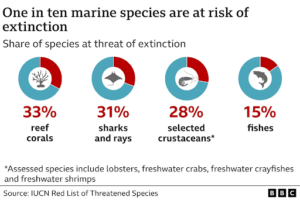In news– Recently, Negotiations involving 168 countries, including the European Union, to agree on a UN treaty for protecting oceans has failed.
What is UN High Seas treaty?
- Also referred to as the ‘Paris Agreement for the Ocean’, the treaty to deal with Biodiversity Beyond National Jurisdiction has been under discussion for several years.
- The proposed treaty concerns the ocean existing beyond the Exclusive Economic Zones that lie from the coast of a country to about 200 nautical miles or 370 km into the sea, till where it has special rights for exploration. Waters beyond that are known as open seas or high seas.
- In June 2022, UN Secretary-General Antonio Guterres had declared an “ocean emergency” at the UN Ocean Conference in Lisbon, Portugal, citing threats to the world’s oceans.
- The treaty was to be negotiated under the United Nations Convention on Laws of the Sea (UNCLOS) of 1982 which governs the rights of countries regarding marine resources.
- As there is no treaty for conserving the health of vast swathes of the earth’s oceans, a UN resolution in 2017 had decided to rectify this while setting 2022 as the deadline.
- The pandemic resulted in many delays, and later, a High Ambition Coalition, which now has more than 100 countries including India, the US, and the UK, came about and put the focus on ‘30×30’ goals – protecting 30% of the ocean by 2030.
- After the latest deadlock, talks will only resume in 2022, unless a special session is called.
- Some aspects of negotiations included establishing marine protected areas to put limits on certain activities, environmental impact assessments or clearances for sustainability of works, financial support to countries and sharing other scientific knowledge.

Regulation of world’s oceans as of now-
- Some treaties, along with the UNCLOS, regulate the conduct of actors on the high seas.
- UNCLOS lays down a comprehensive regime of law and order in the world’s oceans and seas establishing rules governing all uses of the oceans and their resources.
- It embodies in one instrument traditional rules for the uses of the oceans and at the same time introduces new legal concepts and regimes and addresses new concerns.
- The Convention also provides the framework for further development of specific areas of the law of the sea.
- The Division for Ocean Affairs and the Law of the Sea (DOALOS) of the Office of Legal Affairs of the United Nations serves as the secretariat of the Convention on the Law of the Sea and provides information, advice and assistance to States with a view to providing a better understanding of the Convention and the related Agreements, their wider acceptance, uniform and consistent application and effective implementation.
- The UNCLOS led to the establishment of territorial sea boundaries 22 km offshore, deciding the region up to which countries could claim full sovereign territorial rights, as well as the 200 nautical miles EEZ limit.
- It also created the International Seabed Authority and other conflict-resolution mechanisms.
- But a treaty dedicated to protecting ocean health does not exist as of now.
- Conversely, every country has the right to access open seas, resulting in large-scale drilling and trawling operations for catching fish and other animals for commercial purposes.
















